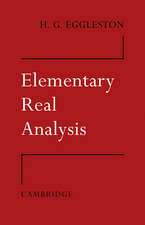A Mathematical Tapestry: Demonstrating the Beautiful Unity of Mathematics
Autor Peter Hilton, Jean Pedersen Ilustrat de Sylvie Donmoyeren Limba Engleză Hardback – 21 iul 2010
| Toate formatele și edițiile | Preț | Express |
|---|---|---|
| Paperback (1) | 270.72 lei 6-8 săpt. | |
| Cambridge University Press – 21 iul 2010 | 270.72 lei 6-8 săpt. | |
| Hardback (1) | 618.69 lei 6-8 săpt. | |
| Cambridge University Press – 21 iul 2010 | 618.69 lei 6-8 săpt. |
Preț: 618.69 lei
Preț vechi: 695.16 lei
-11% Nou
Puncte Express: 928
Preț estimativ în valută:
118.39€ • 128.100$ • 99.76£
118.39€ • 128.100$ • 99.76£
Carte tipărită la comandă
Livrare economică 24 aprilie-08 mai
Preluare comenzi: 021 569.72.76
Specificații
ISBN-13: 9780521764100
ISBN-10: 0521764106
Pagini: 308
Ilustrații: 175 b/w illus.
Dimensiuni: 170 x 244 x 19 mm
Greutate: 0.74 kg
Editura: Cambridge University Press
Colecția Cambridge University Press
Locul publicării:Cambridge, United Kingdom
ISBN-10: 0521764106
Pagini: 308
Ilustrații: 175 b/w illus.
Dimensiuni: 170 x 244 x 19 mm
Greutate: 0.74 kg
Editura: Cambridge University Press
Colecția Cambridge University Press
Locul publicării:Cambridge, United Kingdom
Cuprins
Preface; 1. Flexagons - a beginning thread; 2. Another thread - 1-period paper folding; 3. More paper folding threads - 2-period paper-folding; 4. A number-theory thread - folding numbers, a number trick, and some titbits; 5. The polyhedron thread - building some polyhedra and defining a regular polyhedron; 6. Constructing dipyramids and rotating rings from straight strips of triangles; 7. Continuing the paper-folding and number theory threads; 8. A geometry and algebra thread - constructing, and using, Jennifer's puzzle; 9. A polyhedral geometry thread - constructing braided platonic solids and other woven polyhedra; 10. Combinatorial and symmetry threads; 11. Some golden threads - constructing more dodecahedra; 12. More combinatorial threads - collapsoids; 13. Group theory - the faces of the tri-hexaflexagon; 14. Combinatorial and group theory threads - extended face planes of the platonic solids; 15. A historical thread - involving the Euler characteristic, Descartes' total angular defect, and Pólya's dream; 16. Tying some loose ends together - symmetry, group theory, homologues, and the Pólya enumeration theorem; 17. Returning to the number theory thread - generalized quasi-order and coach theorems; References; Index.
Recenzii
'For some 30 years Peter Hilton and Jean Pedersen have written papers and books on mathematics, both recreational and advanced. Now they have pulled it all together in one exciting and handsome volume. It opens with detailed instructions on how to fold paper flexagons (there are now dozens of websites on these bewildering paper toys), followed by paper models of polygons and curious polyhedra, then on to other fascinating topics. The emphasis throughout is on symmetry and elegance. The writing is clear and informal, and the authors do not hesitate to include lovely proofs in number theory, algebra, geometry, and group theory. The book is a rich 'tapestry, as the authors call it, from first page to last.' Martin Gardner
'The book demonstrates the great unity of mathematics. This is supported by a wealth of instructive illustrations …' Zentralblatt MATH
'The book demonstrates the great unity of mathematics. This is supported by a wealth of instructive illustrations …' Zentralblatt MATH
Notă biografică
Descriere
Build paper polygons and discover how systematic paper folding reveals exciting patterns and relationships between seemingly unconnected branches of mathematics.



















